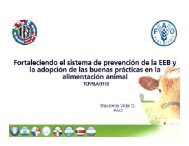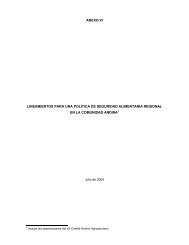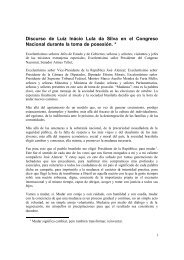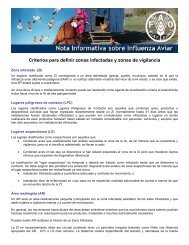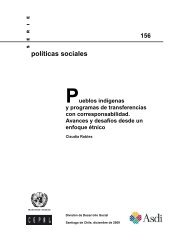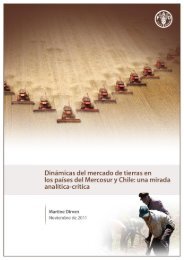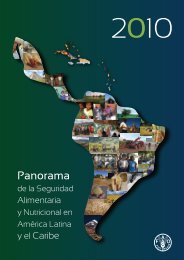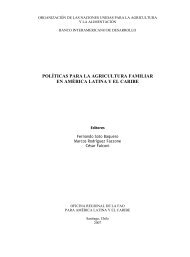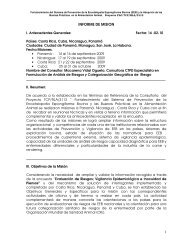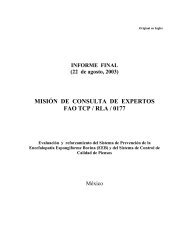Scrapie - Advisory notes for farmers
Scrapie - Advisory notes for farmers
Scrapie - Advisory notes for farmers
- No tags were found...
You also want an ePaper? Increase the reach of your titles
YUMPU automatically turns print PDFs into web optimized ePapers that Google loves.
<strong>Scrapie</strong> –<strong>Advisory</strong> <strong>notes</strong> <strong>for</strong> <strong>farmers</strong>
ContentsIntroduction 2How do I know if my animals have scrapie? 2When does scrapie occur? 2Clinical signs of scrapie 3How can I tell whether these clinical signs are causedby scrapie or another disease? 5What else could these clinical signs indicate? 5Could I definitely recognise scrapie straight away? 5What would happen if I did not report a suspected scrapie animal? 6What will happen when I report that I suspect an animal has scrapie? 6What about the rest of my flock or herd? 7What happens if the Veterinary Officer does not diagnose scrapie? 8Why is it vital to report scrapie? 9Compensation 10Can I do anything to stop my animals contracting scrapie? 10What records do I need to keep? 11‘Genotyping’: What is it, and how can it help me? 12National <strong>Scrapie</strong> Plan (NSP) 13NSP genotypes table 14NSP semen archive 15TSE testing – active surveillance 17Further in<strong>for</strong>mation 18Defra website 19<strong>Scrapie</strong> video 201
Solvents Introduction emissions directive<strong>Scrapie</strong> is a fatal brain disease of sheep and goats. Disease develops due tochanges in a protein present in the brain known as prion protein. It has beenpresent in British sheep <strong>for</strong> over 200 years. By law, any animals suspected ofhaving scrapie must be reported to your local Animal Health Divisional Office(AHDO). It is important that every single suspected case of scrapie is reported,not just the first case on your farm. We need more research into scrapie toestablish how common the disease is, and to find out the similarities anddifferences between scrapie and other similar diseases such as BSE, a diseasefound in cattle, and CJD, a rare disease that is found in humans. To do this,we need <strong>farmers</strong> to look out <strong>for</strong> any signs of this disease, and to reportit immediately.This leaflet will tell you what signs to look out <strong>for</strong> in your sheep and goats,and what to do if you think they may have scrapie.How do I know if my animals have scrapie?There is often a general change in temperament or behaviour weeks be<strong>for</strong>emore specific signs develop. In most cases animals will show a combinationof signs, but none of the signs alone can be regarded as a definite indicationof scrapie. <strong>Scrapie</strong> should be considered in any sheep or goat showingnervous signs or changes in behaviour. If there is no obvious alternativediagnosis, the case must be reported to your Divisional Veterinary Manager(DVM) <strong>for</strong> further investigation.When does scrapie occur?AgeMost cases of scrapie occur in sheep between two and five years of age.Although rarely seen in sheep less than one year of age or over five years old,age alone cannot be used to rule out the presence of scrapie.2
It is rarely reported in goats in the UK but, again, the possibility of the diseasecannot be ruled out.Numbers affectedBecause clinical signs of disease appear a long time after initial infection,cases generally appear singly in a flock. This is very different from diseasessuch as sheep scab (psoroptic mange), which can spread quickly through aflock. Occasionally, several cases can occur over a short period of time, mostlyin animals born at about the same time and possibly to the same sire.SeasonCases can occur at any time of year, but stress can cause the clinical signs toappear. Cases are often more easily identified at times when sheep and goatsare collected <strong>for</strong> management purposes, such as when sheep are brought in<strong>for</strong> lambing, or in the autumn, at tupping.Development of clinical signsMost sheep show a gradual development of clinical signs over a period ofseveral weeks or even months, although in some cases an animal’s conditionmay worsen rapidly. Some sheep and goats affected with scrapie may just befound dead without showing any clinical signs be<strong>for</strong>ehand.Clinical signs of scrapieIrritation●●●repeated rubbing of flanks and hindquarters against objects such asfences, posts or hay racksrepeated scratching of the flanksnibbling or grinding teeth when rubbing themselves or when rubbedfirmly on the back3
●●●continued scratching of the shoulder or ear with a hind footunusual or agitated nibbling of the feet, legs or other parts of the bodyexcessive wool loss or damage to the skinChanges in behaviour●●●●●●becoming excitabledrooping earsincreased nervousness or fear responselagging behindaggressiondepression or vacant stareChanges in posture and movement●●●●●●●trembling (mainly of the head)unusual high stepping trot in early stagessevere incoordinationstumblingstanding awkwardlyweak hind legsunable to standLater clinical signs●●weight lossdeath4
How can I tell whether these clinical signs are caused byscrapie or another disease?When a combination of the signs on pages 3–4 has been noticed, it ispossible your animal has scrapie. You or your vet must report thesuspicion to the Divisional Veterinary Manager (DVM) at your local AnimalHealth Divisional Office. A Veterinary Officer will visit (free of charge) toexamine the suspect animal. IF IN DOUBT, CALL US OUT. WE WOULDRATHER VISIT A CASE WHICH TURNS OUT NOT TO BE SCRAPIE THANMISS A GENUINE CASE.What else could these clinical signs indicate?If single signs occur it is possible that other causes may be to blame:●●●Irritation: can also be caused by skin parasites such as sheep scab mitesor lice.Changes in posture and movement: can also be seen in otherinfectious nervous diseases (such as ‘Gid’, listeriosis, or Maedi-Visna andnon-infectious diseases (such as hypomagnesaemia and pregnancytoxaemia).Excessive weight loss: can also be seen in many other illnesses.Could I definitely recognise scrapie straightaway?In individual sheep and goats, scrapie takes a long time to develop, and inthe early stages of the disease process there may be no overt clinical signs ofthe disease. Clinical signs usually appear months or even years after theanimal has become infected. The only certain way to find out if an animal hasscrapie is by doing laboratory tests on tissues taken from the animal after itsdeath. There is no test available yet which can reliably identify infected liveanimals be<strong>for</strong>e they develop clinical signs although we are optimistic that onewill become available within the next few years.5
What would happen if I did not report a suspectedscrapie animal?The penalties <strong>for</strong> not reporting suspected cases of scrapie are severe. Underthe TSE Regulations 2002, failure to comply can result in heavy fines orimprisonment, or both. In addition the scrapie compensation payments willnot be made.What will happen when I report that I suspect an animalhas scrapie?As explained earlier, once suspicion of scrapie has been notified to the DVMat your local Animal Health Divisional Office, a Veterinary Officer will visit toexamine the animal to confirm or rule out the suspicion of scrapie. If scrapieis suspected, the animal will be humanely slaughtered by lethal injection. Thismay take place on the farm or holding, but the animal may be transportedto a veterinary diagnostic laboratory (at Government expense) if welfareconditions allow.Transport of live animals to the laboratory means that fresh tissues can becollected; this is very important to enable further research into the disease.Samples of brain and other tissues will then be submitted to a specialistlaboratory within the Veterinary Laboratories Agency <strong>for</strong> diagnosis andresearch and the carcase will be incinerated. When the tests are completeyou will be in<strong>for</strong>med whether or not scrapie was confirmed by thelaboratory examination.If the clinical examination of the suspect animal by a Veterinary Officer isinconclusive, the suspect animal will be placed under a movement restrictionon the farm where it is examined. These restrictions will remain in place <strong>for</strong>up to 28 days. The suspect animal is not required to be isolated from otheranimals unless it is likely to give birth while under restriction. The animal willbe seen again by the Veterinary Officer within a few days.6
What about the rest of my flock or herd?If scrapie is confirmed in a sheep or goat on a holding, there can beimplications <strong>for</strong> all of the sheep and goats on that holding.New or further cases of confirmed scrapieFrom Summer 2004, new European legislation will be implemented wherebyowners have to join the Compulsory <strong>Scrapie</strong> Flocks Scheme.In most cases, all of the sheep on the holding will be genotyped. Restrictionswill then be applied on the sheep that can be used <strong>for</strong> breeding on theholding, or sold off <strong>for</strong> breeding or <strong>for</strong> slaughter <strong>for</strong> human consumption orthat have to be destroyed, based on their relative resistance or susceptibilityto scrapie. In exceptional circumstances it may be agreed with the owner thatall of the sheep should be culled. Goats on the affected holding will beculled, as they are known to be uni<strong>for</strong>mly susceptible to scrapie.For flocks that have had scrapie in the pastThose flocks which have had a confirmed case of scrapie between July 1998and Spring 2004 will be invited to join the Voluntary <strong>Scrapie</strong> Flocks Schemewhich has similar but less onerous rules than that <strong>for</strong> the Compulsory <strong>Scrapie</strong>Flocks Scheme. Note – if you have a confirmed case of scrapie after theCompulsory <strong>Scrapie</strong> Flocks Scheme (CSFS) is introduced, the provisions of theCSFS will be implemented on your holding. If you are already a member ofany other National <strong>Scrapie</strong> Plan scheme, that membership will be cancelled.Please see the National <strong>Scrapie</strong> Plan web-pages <strong>for</strong> the most up to dateposition on both schemes (www.defra.gov.uk/nsp) or phone the NSPHelpline – 0845 601 4858.7
Trading with the EUTrading of breeding sheep and goats within the EU is subject to regulatoryrequirements designed to control, among other things, the spread of scrapie.The <strong>Scrapie</strong> Monitoring Scheme is designed to assist producers who wish toexport breeding animals under these arrangements by offering a system thatconfirms that their flock/herd has been monitored <strong>for</strong> scrapie. The scheme iscurrently under review and there<strong>for</strong>e its requirements may change, butfurther details about the current arrangements can be obtained from yourlocal Animal Health Divisional Office.Since 1 October 2003, breeding sheep of the most resistant ARR/ARRgenotype (see National <strong>Scrapie</strong> Plan Genotypes Table on page 14) can beexported even if they have come from a holding that has had scrapie withinthe previous three years. Nevertheless, they must have been genotyped bythe Veterinary Laboratories Agency (VLA) or a laboratory authorised by theGovernment under the National <strong>Scrapie</strong> Plan (NSP).All other genotypes must continue to comply with the regulatoryrequirements, including the stipulation that no case of scrapie has beenconfirmed on the holding <strong>for</strong> at least three years.However, it should be noted that, regardless of genotype, sheep and goatscan only be exported to Denmark and/or Sweden if their flocks have not hada case of scrapie confirmed in the previous seven years.What happens if the Veterinary Officer does not diagnosescrapie?If the Veterinary Officer considers that the signs are not caused by scrapie, norestrictions will be served on the animal. You may then wish to contact yourvet to discuss an alternative diagnosis, or treatment. If you retain the animal8
and signs of scrapie recur, you should report your suspicions again to theDivisional Veterinary Manager.Why is it vital to report scrapie?A continuing scrapie problem in a flock would probably severely affect afarmer’s business. An additional factor is that, whilst this disease does notappear to pose any direct risk to human health, there is a theoreticalpossibility that BSE is present in sheep in the UK. Although, so far, it has notbeen found naturally, laboratory research has shown that sheep can beartificially infected with BSE. Because the external signs of scrapie andexperimentally induced BSE are similar, if BSE is in sheep, scrapie may be“masking” it. There<strong>for</strong>e, to demonstrate that everything is being done toprotect public and animal health, the Government needs to check anysuspicion of a scrapie-like illness in sheep and goats.Reporting any suspect animals is there<strong>for</strong>e vital in this regard and at the sametime provides much needed materials to support the Government’s researchprogramme which aims to:●●●●improve knowledge of the diseaseimprove control of the diseaseprotect animal welfareprevent financial difficulties <strong>for</strong> the farmer by preventing loss of animals,including valuable breeding stockAs we improve our knowledge about the disease, where it is, how it spreads,and how it can be detected, we may have an opportunity to develop an evenmore effective long-term control programme. All <strong>farmers</strong> are there<strong>for</strong>eencouraged to report their suspicion of the disease, not just because itis a legal requirement, but in order to safeguard the future of the sheepindustry. Any evidence that scrapie cases are not being reported also9
undermines Government ef<strong>for</strong>ts to improve or maintain export trade insheep and sheep products.CompensationCompensation is paid <strong>for</strong> reported scrapie suspects that are compulsorilyslaughtered <strong>for</strong> diagnosis. For sheep or goats that are confirmed as havingscrapie (following a laboratory examination), the compensation to be paid is£30 <strong>for</strong> a cull animal at the end of its productive life and £90 <strong>for</strong> any otheranimal. When the tests on the brain tissues are complete you will bein<strong>for</strong>med as to whether or not scrapie has been confirmed by the laboratoryexamination. A higher level of compensation (linked to the true replacementcost, but limited to a maximum of £400) may be paid where a suspect animalis compulsorily slaughtered, but the laboratory diagnosis is unable to confirmscrapie. In addition to this, we will pay the diagnosis and carcase disposalcosts. (Compensation costs correct at time of printing.)Compensation will also be paid <strong>for</strong> animals slaughtered under the Voluntaryand Compulsory <strong>Scrapie</strong> Flocks Schemes (see page 7).Can I do anything to stop my animals contracting scrapie?The disease is caused by an infectious agent, which appears to betransmitted from a ewe to her lamb, and to other sheep. The way it istransmitted from sheep to sheep is not fully understood, but infected birthfluids, membranes and cleansings (placenta or afterbirth) probably spread theagent around pastures or buildings during lambing. Sheep should not bepermitted to eat placenta.Regular cleaning of buildings used <strong>for</strong> lambing may reduce the risk ofexposure of the sheep to the agent. Timely and complete disposal ofcleansings is considered to be particularly important. These methods may10
help to control the spread of scrapie within a flock, but they are unlikely tobe 100% effective.In some cases scrapie has been successfully controlled by culling the relativesof scrapie cases from the flock/herd. To be successful this requires clearidentification of animals and adequate record keeping. You can also breedincreased natural resistance into sheep flocks through the use of scrapiegenotyping (see later section on genotyping). You should also ensure thatsheep are purchased from verified sources.What records do I need to keep?It is very important that your records are kept up to date. It is particularlyimportant that records of a flock’s breeding and management history areheld. Records kept under the rules of the Sheep Annual Premium Scheme, orthose required under the Sheep and Goats Identification and Movement(Interim Measures) (England) (No.2) Order 2002 (as amended) – or under the11
equivalent legislation <strong>for</strong> Wales and Scotland (see below) – are not likely tobe adequate to effectively manage an outbreak of scrapie by selectivebreeding from unaffected, possibly scrapie resistant, animals. (Equivalentlegislation <strong>for</strong> Wales and Scotland is The Sheep and Goats Identification andMovement (Interim measures) (Wales) (No.2) Order 2002 (as amended) andThe Sheep and Goats Identification (Scotland) Amendment Regulations2002.) All movements on and off the farm require recording in the on-farmrecord book. This includes movements to tack, common grazing and withinSole Occupancy Authorities (SOAs).The combination of movement records and the use of earmarks in breedingrecords does help to tackle the problem when disease is found. All lambs andkids must be individually identified; there is, however, no correspondingrequirement to record individual identification numbers.‘Genotyping’: What is it, and how can it help me?Studies have shown that there is a gene in sheep that determines whetheran animal is likely to develop scrapie if exposed to infection. Certain sheep,if exposed to scrapie, are there<strong>for</strong>e more likely to get the disease than others.Goats appear to be more uni<strong>for</strong>mly susceptible, but the same gene maycontrol the time it takes <strong>for</strong> clinical signs to show. So, by careful recordkeeping and a strict breeding plan, it is possible to reduce the number ofcases in a flock by selectively breeding to produce sheep which are least likelyto get the disease. It is possible to identify resistant or susceptible sheep by ablood test. This test, on a small blood or tissue sample, is called ‘genotyping’and the result is known as the ‘genotype’ of the animal.Genotyping and breeding <strong>for</strong> resistance were recommended by the EuropeanUnion Scientific Steering Committee and the Spongi<strong>for</strong>m Encephalopathy<strong>Advisory</strong> Committee and is also endorsed by the Food Standards Agency asa valuable tool in the control of scrapie.12
National <strong>Scrapie</strong> PlanThe National <strong>Scrapie</strong> Plan (NSP) is a long-term plan which consists of anumber of genotyping schemes and initiatives aimed at increasing thegenetic resistance to scrapie in the national sheep flock.The NSP Genotypes Table on the next page shows the 15 known genotypeswhich occur in sheep and their relative resistance or susceptibility to scrapie.The prevalence and frequency of each genotype differs between breeds. Thistable is subject to continuous scientific review.13
NSP genotypes tableGenotype NSP Degree of resistance/susceptibilityresult TypeARR / ARR 1 Sheep that are genetically most resistant toscrapie.ARR / AHQ 2 Sheep that are genetically resistant to scrapie,ARR / ARHbut will need careful selection when used <strong>for</strong>ARR / ARQfurther breeding.AHQ / AHQ 3 Sheep that genetically have little resistanceAHQ / ARHto scrapie.AHQ / ARQSale and breeding restrictions apply in NSP flocks,ARH / ARHwhich are breed specific.ARH / ARQARQ / ARQARR / VRQ 4 Sheep that are genetically susceptible to scrapieand should not be used <strong>for</strong> breeding unless in thecontext of an approved and controlled breedingprogramme.AHQ / VRQ 5 Sheep that are highly susceptible to scrapieARH / VRQand should not be used <strong>for</strong> breeding.ARQ / VRQVRQ / VRQCurrent science indicates that as a result of the NSP we should, in due course,see a very significant reduction in the incidence of scrapie and eventually itsdisappearance from the national flock. It is hoped that as many eligiblebreeders as possible will want to play their part in the NSP.14
All genotyping, electronic identification and certification are free in NSPflocks. For the <strong>for</strong>eseeable future it is likely that NSP certified resistant ramsmay realise higher prices at some breed sales.European Commission Decision 2003/100 EC requires Member States tointroduce genotype based sheep breeding programmes <strong>for</strong> resistanceto Transmissible Spongi<strong>for</strong>m Encephalopathies (TSEs), including scrapie, on acompulsory basis from 1 April 2005.NSP semen archiveThe Semen Archive is being established to store semen from rams of thosegenotypes that over time will be removed through Ram GenotypingSchemes. This archive should enable the re-establishment of viablepopulations of these sheep in the future if it is thought necessary. It will alsohelp to protect against the possible loss of beneficial breed characteristicssuch as hardiness.Operations will be overseen by a joint Industry-Government ManagementBoard, who will approve the nomination of rams, which must be via breedsocieties. If you wish to find out more about the Semen Archive pleasecontact your breed society, or the National <strong>Scrapie</strong> Plan AdministrationCentre (see below <strong>for</strong> contact details). The Semen Archive ManagementBoard Secretariat can also provide in<strong>for</strong>mation:Tel: 01684 892661E-mail: samb@nationalsheep.org.uk15
For more in<strong>for</strong>mation on the NSP, or genotyping, please contact:NSP Helpline: 0845 601 4858 (calls charged at local rate)Or write to:National <strong>Scrapie</strong> Plan Administration CentreDefraWhittington RoadWorcesterWR5 2SUE-mail: nspac@defra.gsi.gov.ukWeb pages: http://www.defra.gov.uk/nspA three year research project has been commissioned to see if there may beassociations between scrapie genotyping and per<strong>for</strong>mance, survival andhealth characteristics.For more in<strong>for</strong>mation about the project, or to register an interest inparticipating, please contact the Veterinary Laboratories Agency (VLA)(see below <strong>for</strong> contact details).In addition, both the VLA and the Institute <strong>for</strong> Animal Health (IAH) arerunning studies on the spread and control of scrapie.For further in<strong>for</strong>mation on enrolling in one of the scrapie studies at VLA orIAH contact:Rachel EglinVeterinary Laboratories Agency, Addlestone,Surrey KT15 3NBTel: 01932 357775E-mail: r.d.eglin@vla.defra.gsi.gov.uk16
Matthew BaylisInstitute <strong>for</strong> Animal Health, Compton, Newbury, BerkshireRG20 7NNTel: 01635 578411E-mail: matthew.baylis@bbsrc.ac.ukTSE testing – active surveillanceUnder EU Regulation 999/2001 (as amended) the UK is currently required totest a prescribed number of sheep aged over 18 months and slaughtered <strong>for</strong>human consumption (abattoir survey). These samples will be taken at theabattoirs that process this category of sheep.The Regulation also requires the testing of a prescribed number of sheep andgoats aged over 18 months and not destined <strong>for</strong> human consumption (fallenstock survey). These samples will be collected directly from farms. Farmersoffering fallen stock should in the first instance contact their local AnimalHealth Divisional Office.For any queries on fallen stock active surveillance please contact:TSE <strong>Scrapie</strong> Testing SectionDefra(020) 7904 653817
Further in<strong>for</strong>mationIf you have any queries or concerns regarding scrapie, please first contact theDivisional Veterinary Manager at your local Animal Health Divisional Office.Contact details are at:http://www.defra.gov.uk/corporate/contacts/ahdo.htmor in your local telephone directory. You may, of course, wish to discuss anysuspicions of scrapie in your flock/herd with your own vet.Alternatively you can direct any questions to officials at the main offices ofthe relevant Agriculture and Rural Affairs Departments.For England:Department <strong>for</strong> Environment, Food and Rural Affairs (Defra)Area 2/041a Page StreetLondon SW1P 4PQTel: (020) 7904 6175For Scotland:Scottish Executive Environment and Rural Affairs Department (SEERAD)Room 349, Pentland House47 Robb’s LoanEdinburgh EH14 1TYTel: (0131) 244 6413E-mail: scrapie@scotland.gsi.gov.uk18
For Wales:Welsh Assembly Government, Department of Environment, Planning andCountryside (DEPC)Animal Health Division 1, Cathays ParkCardiff CF10 3NQTel: (029) 2082 5996You may also wish to find out more about scrapie through the followingsources:Defra websiteIf you have access to the Internet, as well as the in<strong>for</strong>mation on the NSPwebsite you can view the latest general scrapie in<strong>for</strong>mation on Defra’sInternet website, at the following location:http://www.defra.gov.uk/animalh/bse/bse-science/level-4-scrapie.html - this web address is subject to change.This website provides further details on areas such as research, symptoms,genetics, incidence, surveillance and controls, as well as specific in<strong>for</strong>mationon goats and many other subjects.19
<strong>Scrapie</strong> videoA video on the subject of scrapie in sheep and goats is also available fromDefra entitled:<strong>Scrapie</strong>: clinical signs in sheep and goats(1995, 19 minutes, V785)The video is available at the cost of £5.00 excluding VAT from:Defra Publicity Branch, Room 221,Whitehall Place (East Block),London SW1A 2HHFor enquiries, please telephone: 020 7270 8725Fax enquiries: 020 7270 8717or by E-mail to: peter.millard@defra.gsi.gov.ukPrices include postage and packing to all destinations.20
Produced by Defra on behalf of the Agricultural Departments of Great BritainAll in<strong>for</strong>mation contained in this brochure was correct at time of going to press(April 2004).Printed on recycled paper containing 80% post consumer waste and20% totally chlorine free virgin pulpFurther copies can be obtained from Defra Publications, Admail 6000,London SW1A 2XX (Tel: 08459 556000)© Crown copyright 2004. PB 9446




